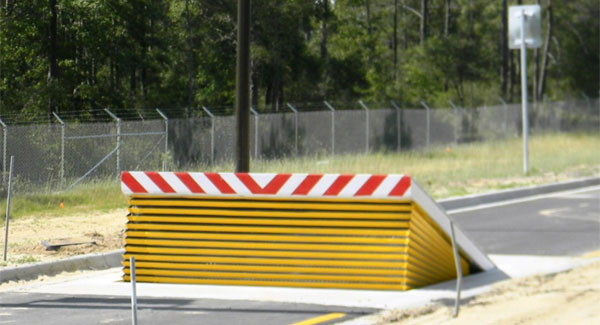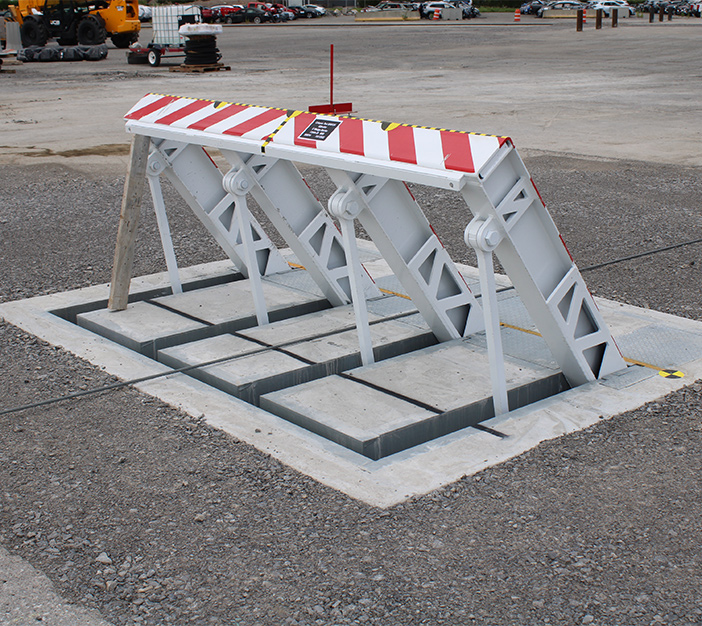Examine This Report on Wedge Barriers
Some Known Incorrect Statements About Wedge Barriers

Unknown Facts About Wedge Barriers
The remaining pressure used to
the cam camera deploy the wedge plate 16 may be provided offered an electromechanical actuator 84 or other various other. The spring setting up 54 and the actuator 84(e. Wedge Barriers. g., electromechanical actuator)may operate together to convert the camera and raise the wedge plate 16.
As stated above, the springtime assembly 54 exerts a constant pressure on the cam, while the electromechanical actuator might be managed to apply a variable force on the web cam, consequently allowing the lifting and decreasing( i. e., deploying and withdrawing )of the wedge plate 16. In specific embodiments, the continuous force applied by the spring assembly 54 may be adjustable. g., electromechanical actuator) is impaired. As will certainly be appreciated, the spring setting up 54 might be covered and safeguarded from particles or other aspects by a cover plate(e. g., cover plate 68 displayed in FIG. 4) that may be significantly flush with the elevated surface 38 of the foundation 14. As stated over, in the deployed position, the wedge plate 16 offers to obstruct accessibility or traveling beyond the barrier 10. The obstacle 10(e. g., the wedge plate 16 )may obstruct pedestrians or cars from accessing a property or pathway. As gone over above, the obstacle 10 is affixed to the support 30 protected within the foundation 14,

front brackets 71. As an outcome, the affiliation settings up 72 might visit site pivot and rotate to find out this here make it possible for the collapse and extension of the linkage settings up 72 during retraction and release of the bather 10. The affiliation assemblies 72 cause movement of the wedge plate 16 to be limited. For instance, if a vehicle is taking a trip towards the released wedge plate 16(e. For instance, in one scenario, the security legs 86 may be extended throughoutupkeep of the barrier 10. When the safety legs 86 are released, the safety and security legs 86 sustain the weight of the wedge plate 16 versus the surface area 12. Consequently, the lifting device 50 may be shut off, serviced, eliminated, changed, etc. FIG. 5 is partial viewpoint sight of an embodiment of the surface-mounted wedge-style barrier 10, showing the web cam 80 and the cam surfaces 82 of the training device 50. Specifically, two webcam surface areas 82, which are referred to as reduced webcam surfaces 83, are placed listed below the camera 80. The lower webcam surface areas 83 may be dealt with to the surface area 12 (e. For instance, the reduced web cam surface areas 83 and the mounting plate 85 might create a single piece that is his response secured to the anchor 30 by bolts or other mechanical fasteners. Additionally, 2 cam surface areas 82, which are described as upper webcam surface areas 87, are placed above the camera 80 and paired to (e. In various other embodiments, intervening layers or plates may be positioned between the surface area 12 and the lower webcam surface areas 83 and/or the wedge plate 16 and the upper web cam surface areas 87 As pointed out over, the cam
80 translates along the web cam surface areas 82 when the wedge plate 16 is lifted from the pulled back setting to the released position. Additionally, as mentioned above, the spring assembly 54 (see FIG. 3 )might offer a pressure acting on the web cam 80 in the instructions 102 using spring rod 58, which might minimize the force the electromechanical actuator 84 is called for to put on the web cam 80 in order to actuate and raise the wedge plate 16. 1 )to the deployed position(see FIG. 4). As shown, the cam 80 consists of track wheels 104(e. g., rollers), which call and convert along the web cam surface areas 82 throughout operation.